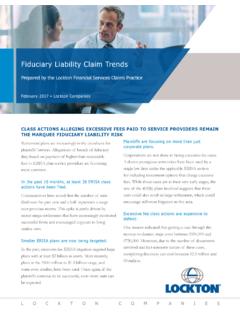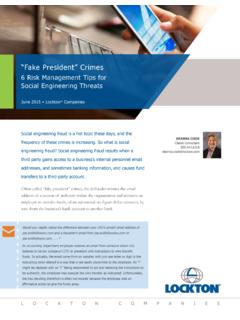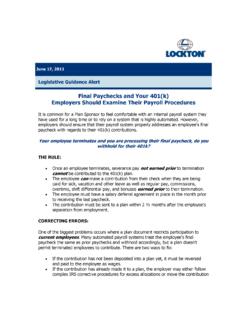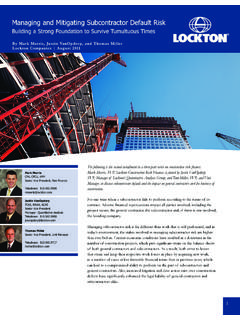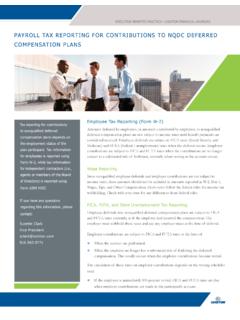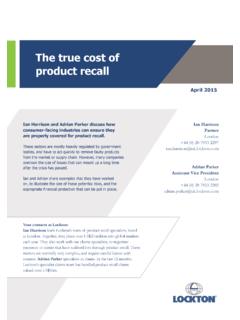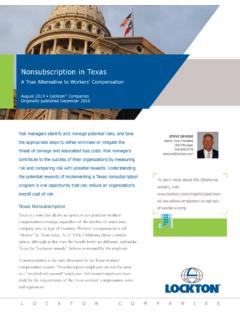Transcription of Employment Practices Liability Claim Trends - lockton.com
1 Employment Practices Liability Claim TrendsPrepared by the Lockton Financial Services Claims PracticeApril 2017 Lockton CompaniesLOCKTON COMPANIESFY2016 SAW AN INCREASE IN EEOC CHARGES, BUT NUMBERS REMAIN BELOW RECESSION ERA LEVELSThe 2016 fiscal year saw 91,503 charges filed with the Equal Employment Opportunity Commission (EEOC), making it the second year in a row this number has grown. But the number of charges in FY2016 was still below the recession era yearly average of 96,948 charges filed from 2008 through 2013. In comparison, an average of 80,218 charges was filed during the ten years before the chart below illustrates the types of charges filed:The primary reasons for the growth of EEOC filings are the sizeable increases in retaliation, disability, and age discrimination Charges89,385 Race31,027 Sex26,396 National Origin9,438 Religion3,502 Color2,833 Retaliation All Statutes39,757 Retaliation Title VII only31,893 Age20,144 Disability26,968 Equal Pay Act973 GINA25731,02726,3969,4383,5022,83339,757 31,89320,14426,96897325705,00010,00015,0 0020,00025,00030,00035,00040,00045,000FY 2016 EEOC Charges2 april 2017 Lockton CompaniesAs you might expect, a handful of states led the way with a number of charges filed.
2 FY2016 EEOC Charges Filed by StateFY2016 EEOC Charges Filed By State Workplace class actions settlement values fell in 2016, except for wage and hour Big workplace class action settlements were largely lower in 2016. For example, the top ten discrimination class action settlements fell by more than 70%, from about $296 million in 2015 to nearly $80 million in 2016. Likewise, in actions brought by the EEOC and the US Department of Labor (DOL), settlements fell year-over-year from approximately $83 million to almost $52 million in Because year-to-year settlement activity is unpredictable, it remains to be seen whether these downward Trends will continue in 2017 . Settlements of wage and hour claims were the notable exception to the general decline in workplace settlements. Wage and hour settlements continued their explosive growth from $215 million in 2014 to $464 million in 2015 and to $696 million last The growth of wage and hour claims and settlements is not expected to slow down in 2017 .
3 Wage and hour enforcement activity remains very active The DOL s Wage and Hour Division (WHD) continues to be very active. In FY2016 the WHD responded to over 20,000 complaints, and recovered a near record $266,566,178 on behalf of 283,667 The chart below summarizes the WHD s activity in recent years: 0 to 1,0001,000 to 2,0002,000 to 3,0003,000 to 4,0004,000 to 5,0005,000 to 6,0006,000 to 7,0007,000 to 8,0008,000 to 9,0009,000 or moreWORKPLACE CLASS ACTION SETTLEMENT VALUES FELL IN 2016, EXCEPT FOR WAGE AND HOURBig workplace class action settlements were largely lower in 2016. For example, the top ten discrimination class action settlements fell by more than 70%, from about $296 million in 2015 to nearly $80 million in 2016. Likewise, in actions brought by the EEOC and the US Department of Labor (DOL), settlements fell year over year from approximately $83 million to almost $52 million in Because year-to-year settlement activity is unpredictable, it remains to be seen whether these downward Trends will continue in of wage and hour claims were the notable exception to the general decline in workplace settlements.
4 Wage and hour settlements continued their explosive growth from $215 million in 2014 to $464 million in 2015 to $696 million last The growth of wage and hour claims and settlements is not expected to slow down in 2017 Lockton CompaniesWAGE AND HOUR ENFORCEMENT ACTIVITY REMAINS VERY ACTIVEThe DOL s Wage and Hour Division (WHD) continues to be very active. In FY2016, the WHD responded to over 20,000 complaints and recovered a near record $266,566,178 on behalf of 283,667 The chart below summarizes the WHD s activity in recent years:WHD Enforcement Statistics: All ActsFY 1997FY 1998FY 1999FY 2000FY 2001FY 2002FY 2003FY 2004FY 2005 Back Wages$96,719,108$163,953,081$131,735,341 $163,601,821$131,954,657$175,640,492$212 ,537,554$196,664,146$166,005,014 Employees Receiving Back Wages189,244252,247259,870257,326216,647 263,593342,358288,296241,379 Complaints Registered37,02536,89243,28634,11329,085 31,41331,12331,78630,375 Enforcement Hours740,643909,616982,332**968,350998,9 371,070,6001,032,8791,000,739969,776 Average Days to Resolve Complaint1391291089285 Concluded Cases42,27550,34448,44144,00238,05140,26 439,42537,84234,858 Source.
5 Department of Labor, Wage and Hour Division 050100150200250300350$0$50$100$150$200$2 50$300FY 2007FY 2008FY 2009FY 2010FY 2011FY 2012FY 2013FY 2014FY 2015FY 2016 ThousandsMillionsBack WagesEmployees Receiving Back WagesEEOC S NEW STRATEGIC ENFORCEMENT PLAN (SEP) CONTINUES FOCUS ON COMPLEX Employment STRUCTURES AND EQUAL PAYThe EEOC approved an updated SEP for FY2017-FY2021 that is similar to the one in place and will put renewed emphasis on complex Employment relationships and structures, including temporary workers, staffing agencies, independent contractors, and the on-demand economy exemplified by Uber and other gig economy players. For example, the EEOC, when recently filing suit on behalf of Haitian employees, commented that employers should not be able to avoid Liability by using a staffing agency to discriminate when it cannot lawfully do so on its own.
6 5 The EEOC will expand on its traditional gender-based equal pay protections to focus on race, ethnicity, and disability equal pay protections. The EEOC will also concentrate on discrimination against Muslims and Arabs as well as job qualifications and inflexible leave policies that discriminate against disabled the new SEP was developed under the prior administration, acting EEOC Chair Victoria Lipnic stated that she does not anticipate any changes in enforcement priorities. But many expect the EEOC to become less enforcement-focused and more collaborative with employers and to increase emphasis on job 2017 Lockton CompaniesTHE NEW DOL OVERTIME RULES ARE DELAYED AGAIN AND FACE AN UNCERTAIN FUTUREThe DOL rules for overtime exemptions were expected to nearly double the white-collar exemption threshold and dramatically increase the pool of potential wage and hour plaintiffs.
7 But in a surprise 2016 ruling, a Texas federal court issued an injunction precluding the new rule from taking effect until the court decides whether the DOL overreached its federal authority by promulgating the new rule. Ironically, the DOL has been the one lengthening the injunction, asking for multiple time extensions to file its appeal brief to allow incoming leadership personnel adequate time to consider the issues. Many expect the new administration s Secretary of Labor, Alexander Acosta, to let the rule die a slow ignominious CIRCUIT BECOMES FIRST APPELLATE COURT TO EXPAND DEFINITION OF SEX DISCRIMINATION TO INCLUDE SEXUAL ORIENTATIONB reaking from established precedent, the Seventh Circuit in Hively v. Ivy Tech Community College8 held that discrimination based on sexual orientation is a form of sex discrimination prohibited under federal law.
8 All previous circuit court decisions limited the meaning of sex discrimination to discrimination based on whether someone was male or female. The historic nature of this decision aside, many employers already conduct themselves under this broader standard, as 22 states have laws prohibiting discrimination based on sexual orientation. But this ruling expands such protections to jurisdictions where none previously existed, like Indiana. The Supreme Court has not addressed this issue and the Seventh Circuit limited its holding to exclude religious employers, so this is more likely to be the beginning, and not the end, of this CIRCUIT S PLAINTIFF-FRIENDLY RULING INCREASES LIKELIHOOD FOR WILLFUL VIOLATIONS OF FCRA FOR EMPLOYEE BACKGROUND CHECKSE mployment claims for technical violations of the Fair Credit Reporting Act (FCRA) arising from employee background checks have skyrocketed over the past 18 24 months.
9 The Ninth Circuit in Syed v. M-I, LLC9 added incentive for these suits by becoming the first appellate court to hold that including a Liability waiver or any other extraneous information to a background check disclosure and authorization is a willful violation of the FCRA, subjecting the employer to statutory coverage for FCRA claims is available via workplace privacy wording in Employment Practices Liability (EPL) policies. Much will depend on how the claims are alleged though, as FCRA matters are not traditional EPL hazards that are typically covered under EPL 2017 Lockton CompaniesUS SUPREME COURT TO RULE ON ENFORCEABILITY OF COLLECTIVE ACTION WAIVERS IN Employment ARBITRATION PROVISIONSIn 2011, the Supreme Court approved arbitration provisions in consumer contracts that prohibited collective actions, requiring single-plaintiff arbitrations.
10 That same issue will now be addressed for Employment contracts. The Seventh and Ninth Circuits ruled that the National Labor Relations Act prohibited such waivers because of workers rights to engage in concerted activities, but the Fifth Circuit ruled otherwise. The Supreme Court consolidated all three matters and is expected to rule before July 2017 . If approved, employers may use such waivers to force single-plaintiff arbitration and potentially avoid wage and hour and other Employment -related class Trends FAVOR FRANCHISORS AND OTHER INDIRECT EMPLOYERS IN JOINT-EMPLOYER BATTLEFor decades, franchisors were not deemed to be employers of their franchisees employees because they lacked the necessary control over those employees. Over the past two years, however, this established status came under attack on multiple fronts as employees sought to make franchisors and other beneficiaries of leased employees joint employers and susceptible to workplace lawsuits.

